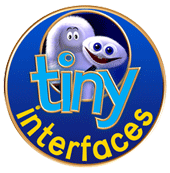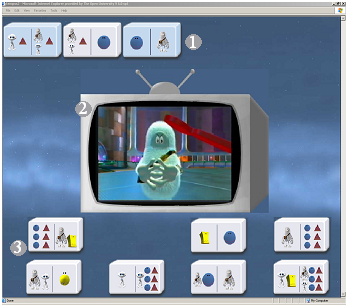About

The Tiny-in project was a two-year EPSRC DTI LINK-funded initiative aimed at exploring innovative ways to create new narratives from existing broadcast content. Content re-use had become increasingly desirable as program-makers sought to recover high production costs through spin-off merchandise, particularly within the emerging interactive DVD market. Rather than merely re-using content, the project focused on preserving the narrative principles underpinning the original broadcasts to ensure a meaningful and enjoyable interactive experience. Narrative was used as a tool to organise content, providing coherence while aiding memory and comprehension.
Scene-Driver
As part of the Tiny-in project, researchers developed Scene-Driver, a narrative-driven game architecture designed for content re-use. Scene-Driver was implemented using animation content from the Tiny Planets children’s television series, produced by Pepper’s Ghost Productions. The project involved creating a methodology for selecting and categorising Tiny Planets clips based on narrative elements, as well as developing a narrative engine capable of generating new plot structures using these descriptions. A key feature of Scene-Driver was its interactive approach, allowing users to actively participate in constructing the narrative. The game was designed for children aged 5-7, aligning with the target audience of Tiny Planets.
Playing the Game
The project team developed an intuitive, iconic interface that enabled young children to engage with Tiny Planets content and create unique narratives. The interface took the form of domino-like tiles, where pictures replaced numbers. A child would place a domino with a left-hand side that matched the clip they had just seen, while the right-hand side determined the properties of the next scene. The narrative engine ensured coherence regardless of the child’s tile choices, guaranteeing that gameplay would always result in a complete story.
The screenshot shows a Scene-Driver demonstrator using the Tiny Planets content, featuring:

- Dominoes that had already been played.
- The current clip, corresponding to the last domino placed.
- The remaining dominoes available for the child to use.
Through this approach, the project successfully combined narrative principles with interactive gameplay, enhancing children’s engagement with broadcast content in an innovative way.
Team
Zdenek Zdrahal
Paul Mulholland
Annika Wolff
Project Partners
Pepper’s Ghost Productions
Edinburgh Virtual Environment Centre
Publications
Wolff, A., Mulholland, P., Zdrahal , Z. and Joiner, R. (2004). Scene-Driver: A Narrative-Driven Game Architecture Reusing Broadcast Animation Content. ACM SIGCHI International Conference on Advances in Computer Entertainment Technology (ACE 2004), Singapore.
Wolff, A., Mulholland, P., Zdrahal , Z. and Joiner, R. (2004). Scene-Driver: Reusing Broadcast Animation Content for Engaging, Narratively Coherent Games. Advanced Visual Interfaces (AVI 2004), Gallipoli, Italy.
Wolff, A., Mulholland, P., Zdrahal , Z. and Joiner, R. (2004). Scene-Driver: An Interactive Narrative Environment using Content from an Animated Children’s Television Series. 2nd International Conference on Technologies for Interactive Digital Storytelling and Entertainment (TIDSE 2004), Darmstadt, Germany.